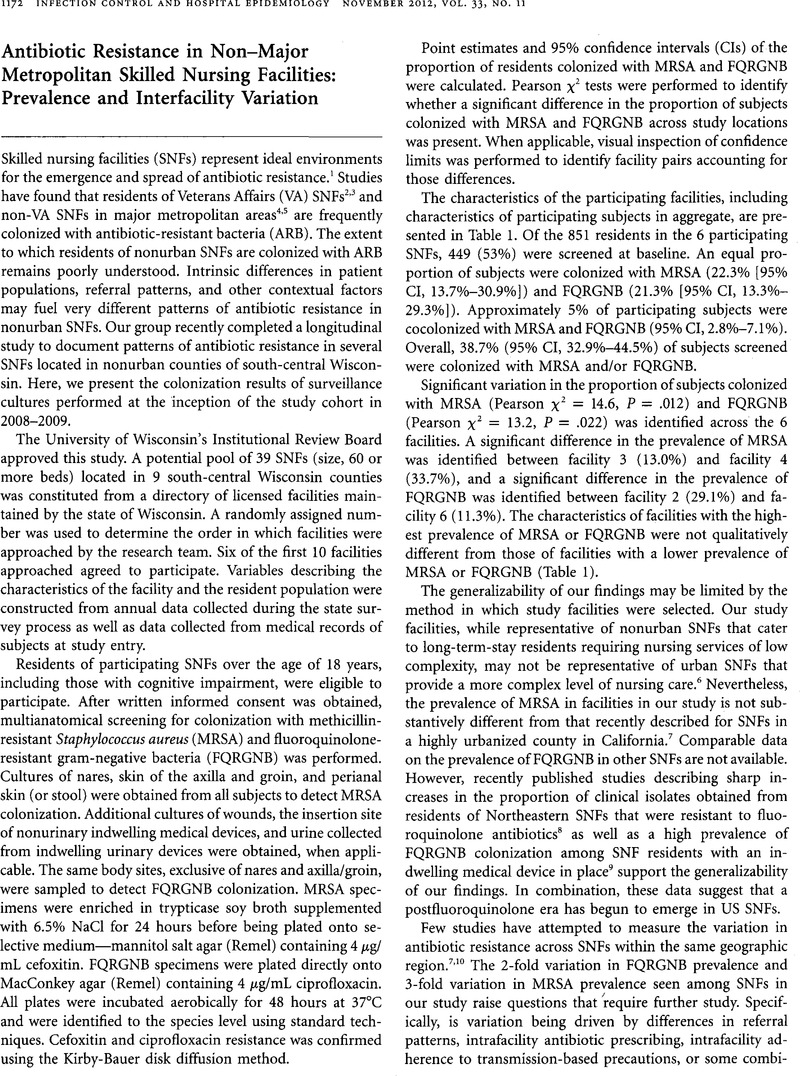Crossref Citations
This article has been cited by the following publications. This list is generated based on data provided by Crossref.
Crnich, Christopher J.
2013.
Impact and Management of MRSA in the Long-Term Care Setting.
Current Translational Geriatrics and Experimental Gerontology Reports,
Vol. 2,
Issue. 3,
p.
125.
Drinka, Paul
Podzorski, Raymond P.
Griffin, Vicky
and
Crnich, Christopher J.
2013.
Antibiogram of Urinary Isolates.
Journal of the American Medical Directors Association,
Vol. 14,
Issue. 6,
p.
443.
Nace, David A.
Drinka, Paul J.
and
Crnich, Christopher J.
2014.
Clinical Uncertainties in the Approach to Long Term Care Residents With Possible Urinary Tract Infection.
Journal of the American Medical Directors Association,
Vol. 15,
Issue. 2,
p.
133.
Roghmann, Mary-Claire
Johnson, J. Kristie
Sorkin, John D.
Langenberg, Patricia
Lydecker, Alison
Sorace, Brian
Levy, Lauren
and
Mody, Lona
2015.
Transmission of Methicillin-Resistant Staphylococcus aureus (MRSA) to Healthcare Worker Gowns and Gloves During Care of Nursing Home Residents.
Infection Control & Hospital Epidemiology,
Vol. 36,
Issue. 9,
p.
1050.
Cassone, Marco
and
Mody, Lona
2015.
Colonization with Multidrug-Resistant Organisms in Nursing Homes: Scope, Importance, and Management.
Current Geriatrics Reports,
Vol. 4,
Issue. 1,
p.
87.
Crnich, Christopher J.
Jump, Robin
Trautner, Barbara
Sloane, Philip D.
and
Mody, Lona
2015.
Optimizing Antibiotic Stewardship in Nursing Homes: A Narrative Review and Recommendations for Improvement.
Drugs & Aging,
Vol. 32,
Issue. 9,
p.
699.
Roghmann, Mary-Claire
Lydecker, Alison
Mody, Lona
Mullins, C. Daniel
and
Onukwugha, Eberechukwu
2016.
Strategies to Prevent MRSA Transmission in Community-Based Nursing Homes: A Cost Analysis.
Infection Control & Hospital Epidemiology,
Vol. 37,
Issue. 8,
p.
962.
Montoya, Ana
Cassone, Marco
and
Mody, Lona
2016.
Infections in Nursing Homes.
Clinics in Geriatric Medicine,
Vol. 32,
Issue. 3,
p.
585.
Batina, Nataliya G.
Crnich, Christopher J.
Anderson, David F.
and
Döpfer, Dörte
2016.
Identifying conditions for elimination and epidemic potential of methicillin-resistant Staphylococcus aureus in nursing homes.
Antimicrobial Resistance & Infection Control,
Vol. 5,
Issue. 1,
Batina, Nataliya G.
Crnich, Christoper J.
Anderson, David F.
and
Döpfer, Dörte
2016.
Models to predict prevalence and transition dynamics of methicillin-resistant Staphylococcus aureus in community nursing homes.
American Journal of Infection Control,
Vol. 44,
Issue. 5,
p.
507.
Stine, O. Colin
Burrowes, Shana
David, Sophia
Johnson, J. Kristie
and
Roghmann, Mary-Claire
2016.
Transmission Clusters of Methicillin-Resistant Staphylococcus Aureus in Long-Term Care Facilities Based on Whole-Genome Sequencing.
Infection Control & Hospital Epidemiology,
Vol. 37,
Issue. 6,
p.
685.
Dumyati, Ghinwa
Stone, Nimalie D.
Nace, David A.
Crnich, Christopher J.
and
Jump, Robin L. P.
2017.
Challenges and Strategies for Prevention of Multidrug-Resistant Organism Transmission in Nursing Homes.
Current Infectious Disease Reports,
Vol. 19,
Issue. 4,
Albrecht, Jennifer S.
Croft, Lindsay
Morgan, Daniel J.
and
Roghmann, Mary-Claire
2017.
Perceptions of Gown and Glove Use to Prevent Methicillin-resistant Staphylococcus aureus Transmission in Nursing Homes.
Journal of the American Medical Directors Association,
Vol. 18,
Issue. 2,
p.
158.
Batina, Nataliya G.
Crnich, Christopher J.
and
Döpfer, Dörte
2017.
Acquisition and persistence of strain-specific methicillin-resistant Staphylococcus aureus and their determinants in community nursing homes.
BMC Infectious Diseases,
Vol. 17,
Issue. 1,
Nace, David A.
Perera, Subashan K.
Hanlon, Joseph T.
Saracco, Stacey
Anderson, Gulsum
Schweon, Steven J.
Klein-Fedyshin, Michele
Wessel, Charles B.
Mulligan, Mary
Drinka, Paul J.
and
Crnich, Christopher J.
2018.
The Improving Outcomes of UTI Management in Long-Term Care Project (IOU) Consensus Guidelines for the Diagnosis of Uncomplicated Cystitis in Nursing Home Residents.
Journal of the American Medical Directors Association,
Vol. 19,
Issue. 9,
p.
765.
Pulia, Michael
Kern, Michael
Schwei, Rebecca J.
Shah, Manish N.
Sampene, Emmanuel
and
Crnich, Christopher J.
2018.
Comparing appropriateness of antibiotics for nursing home residents by setting of prescription initiation: a cross-sectional analysis.
Antimicrobial Resistance & Infection Control,
Vol. 7,
Issue. 1,
Salem‐Schatz, Susanne
Griswold, Paula
Kandel, Ruth
Benjamin‐Bothwell, Sharon
DeMaria, Alfred
McElroy, Nora
Bolstorff, Barbara
McHale, Eileen
and
Doron, Shira
2020.
A Statewide Program to Improve Management of Suspected Urinary Tract Infection in Long‐Term Care.
Journal of the American Geriatrics Society,
Vol. 68,
Issue. 1,
p.
62.



